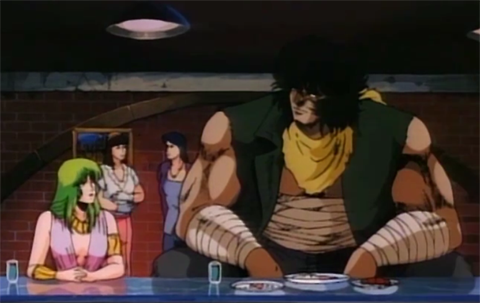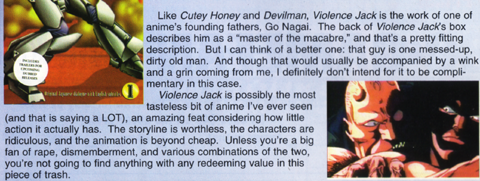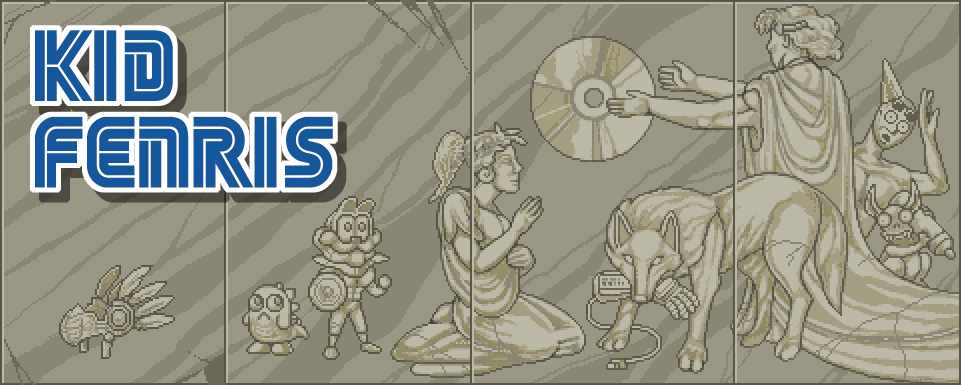Go Nagai is perhaps the most famous perv in the entire history of Japanese comics and cartoons. He rose to infamy in the late 1960s and early 1970s, when Japan’s manga-consuming public hungered for an author who would push the boundaries of comic superheroes, giant robots, and taste. Nagai was there, summoning floods of controversy with his risqué titles, and he didn’t stop with the schoolyard puerility of Harenchi Gakuen. He worked in all sorts of pulp fields, like a performance artist covering himself in robots and demons and naked women before writhing upon a huge, cheaply printed canvas. And the act paid off. Many of Nagai’s comics became industry staples and, of course, prominent animated series. Mazinger, Cutey Honey, Getter Robo, and other Nagai creations are now anime-industry legends.
You won’t find Violence Jack among those legends. Of course, it was successful enough to get a few dozen manga volumes to its name, and it's been relaunched about once a decade since its 1973 debut. Yet it’s never held in as high esteem as Nagai’s more enduring creations, and that may be due to the lack of Violence Jack anime. Companies took three shots at animating Violence Jack, and the results explain why no one else tried after that.
Conceived as a pseudo-sequel to Nagai’s Devilman comics, Violence Jack proved to be a muddled pioneer in post-apocalyptic manga. That apocalypse is a possibly Devilman-related earthquake which destroys civilization, leaving behind vicious remnants of humanity as well as whatever sex and violence Nagai cared to put on the page. It was likely this setting that drew in anime producers back in the 1980s, when Mad Max and Fist of the North Star brought disaster-ravaged worlds into style. Three Violence Jack OVAs were made by largely different production teams, and Manga Entertainment released them all in judiciously censored American form during the 1990s.

Perhaps noting the lack of continuity between the three episodes, Manga started their Violence Jack media blitz with the second OVA, Evil Town. I suspect Manga judged Evil Town as the most controversial of the three episodes, as well as the only one with a remotely interesting (if stupidly implausible) premise: in a city buried by an earthquake, pockets of survivors butcher each other while digging for the surface. Evil Town is also the only Violence Jack OVA put together by anyone important. It was directed by Ichiro Itano, famous for animating the whirlwind missile ballets of Macross, and written by one Noboru Aikawa. Noboru would later change his name to Sho Aikawa and work on The Twelve Kingdoms, Martian Successor Nadesico, and a series called Fullmetal Alchemist. At this point in his career, however, he was still trudging through porn and mediocre OVAs.
Itano prefers his anime gory and grim, so Violence Jack: Evil Town starts with a scruffy police officer named Kawamori gunning down a child for the heinous crime of stealing a ham. So goes life in the buried city's Section A, where politicians and cops ruthlessly strive to maintain order. The boy’s fellow ham thief seeks refuge among the stock 1980s post-apocalyptic bikers of Section B, who quickly murder him. No one quite cares back at Section A, though, because they’ve just dug a gigantic, glowing-eyed dude out of a wall.
Despite some subtle warning signs, Section A's oily leaders decide that the self-named Violence Jack is the answer to their prayers, and they show him off to the thugs of Section B during a big ol’ friendly down-home meet n’ greet. Jack grunts and stares impassively at Mad Saulus, the towering leader of section B, and his transvestite sidekick, Blue. This standoff is interrupted by the arrival of Section C, formed by women who were once raped and assaulted by the men of Section A. Here Itano and Aikawa could make a finely honed statement about the fragile nature of civilization, touching on how savagery and corruption invariably lurk within the halls of power. But no, they just show flashbacks of Section C’s women being violated.
Aila Mu, the green-haired leader of these women, asks Jack to help the beleaguered Section C instead of the hypocritical rapists of Section A or the completely up-front rapists of Section B. Jack’s reaction is priceless, conveyed with that crisp, expressive grace one sees so often in ‘80s anime.

Yet Violence Jack is a walking avatar of death and warfare, not unlike a Cormac McCarthy antagonist. His mere presence inspires Section B to slaughter Section A right down to the children, who no one thinks of during the carnage. Jack eventually butchers Mad Saulus and the rest of the Section B marauders, though not before the villains rape the women of Section C on the way to the surface.

It also happens that there are only two women in Section C willing to take up arms and fight for their lives. Both of them die horrifically, of course. Rikki, the blue-haired aerobics instructor on the left, gets it in the neck when she’s distracted by a man urinating in front of her. Yes, really. Maria, the woman in the track suit, meets a gruesome fate in the uncensored version of Violence Jack and disappears from the story entirely in Manga’s edited release. She’s not the only plot-hole casualty introduced by this clipping, as scenes of cannibalism, child murder, rape, and graphic dismemberment are also trimmed down. The censorship of Violence Jack is a curious tale, one marginally more interesting than the series.

Violence Jack enjoyed two other anime episodes, though neither proved as recklessly horrible as Evil Town. Manga followed the first installment with Hell’s Wind, a.k.a. Violence Jack Kills a Biker Gang: Part 2, though it was the third and final Violence Jack OVA released in Japan. Now above the surface, Jack slices through a roaming gang of Road Warrior stereotypes with the help of a vengeful woman named Jun (above). Once a victim of the gang, Jun manages to wreak modest havoc among them before she meets the usual fate of being captured and tortured. It's as standard a post-apocalyptic plot as you can get, and it ends when Violence Jack murders the wrongdoers and shows a young boy that it’s important to protect your loved ones. Especially if you’re a sadistic, wild-haired giant formed from hell itself.

Manga’s last Violence Jack release was really the first of the OVAs produced in Japan. A dreary little tale called Slumking (or Harlem/Harem Bomber), it initially promises to pit Violence Jack against a major villain from the manga. Yet the titular Slumking barely shows himself; Jack merely fights a bland, headbrace-wearing thug named Harem/Harlem Bomber (above) while another of Slumking's lackeys tries to save his girlfriend and nobody else. Jack's at his most bizarrely mystical here, with characters proclaiming him an instrument of doom before he transforms into a phoenix and takes to the heavens. That doesn't keep Slumking from being the dullest and therefore worst Violence Jack escapade, though for a few seconds the English dubbing makes it the high point of the entire series.
That dub may indeed be the best thing about Violence Jack. It’s by Manga UK, known for putting together subtly British voicework with plentiful swearing and minimally rehearsed performances. Violence Jack has all of that, as characters call each other “yellow shitfuck” and "Captain Buttwipe" amid such rejoinders as “Swivel on this, dyke!” The performances are hilarious, as most of the cast spout their profanity-filled lines as though they’re desperate to get out of the studio and away from this thing in front of them. Every name in the dub's credits looks like a pseudonym, though the actor playing Evil Town's Kawamori sounds a lot like Peter Marinker. Just a coincidence, I’m sure.
Violence Jack’s crude extremes and dubbing have given it quite a reputation among fans of terrible anime, a reputation that I've furthered by uploading those YouTube clips. Yet there’s a sad little secret beneath them: despite its silliness and rampant debauchery, Violence Jack is mostly just hideous and boring. For every ridiculous line or delightful scene of Jack glaring into space, there’s much more in the way of tepid pulp storytelling or drawn-out scenes of rape, torture, and God knows what else. If it weren’t for Go Nagai’s sideburns-heavy style and Manga UK’s dub, Violence Jack would be largely indistinguishable from Vampire Wars, Dark Warrior, and the rest of the disposable, misogynistic direct-to-video effluvia that sprang up in Japan’s anime industry throughout the late 1980s and early 1990s.
In a particularly strange disappointment, Violence Jack doesn’t even have competent fight scenes. Itano shows little of his flair for kinetic action in Evil Town, and Aikawa's script is entirely devoid of tension (in contrast, Itano and Aikawa’s subsequent collaboration, Angel Cop, is offensive and yet never dull). The people behind the other two OVA episodes can't even make Violence Jack entertainingly bad, and few of them went on to better things. It's hard to say how much of the blame Go Nagai shares. He's credited only as the original author, though his Dynamic Planning studio oversaw all three episodes.
Like The Wings of Honneamise and other challenging anime art, Violence Jack provoked strong opinions. Animerica ran the following review.

The complex moral decisions of Violence Jack were lost on other critics, including GameFan Magazine’s Casey Loe.

In North America, Violence Jack was swiftly discarded. Manga Video put out the censored versions and Right Stuff the uncensored ones, but neither company brough the series to DVD. In Europe, Manga UK slapped all three edited, dub-only episodes on one disc while France and Italy saw uncensored DVD collections. An uncut special-edition DVD of Violence Jack, with interviews and a stuffed Jack figure, continues to elude English-speaking fans for some reason.
DOES IT DESERVE A PROPER DVD RELEASE? Yes, as long as you never watch that DVD all the way through, and instead stick it on the shelf for conversational value. Violence Jack may seem like a masterpiece of dreadful anime, but watching it in full is an ugly, tiring experience. It's better appreciated from afar, through clips and quotes and in-jokes that never reveal how wearisome the actual series is. Violence Jack is a creature of legend, and so he must remain.

Old feature is old, but having just read this, I feel the need to add to it. I watched this anime on video some 15 years ago, both the 'Evil Town' OVA, and the 'Jack Vs Biker Gang' OVa and, I must say, certain scenes remain fresh in my mind to this day.
ReplyDeleteIt's justifiable why some people would have huge objections due to these OVAs, especially if you happen to take anything about rape too serious to the point of clouding reality (not naming anyone of course), but for what it's worth, of all the crappy animes I've seen over the years, there's something to be said if Violence Jack has the ability to remain so memorable in my mind when other animes fade out of my mind completely and into obscurity.
-Terramax